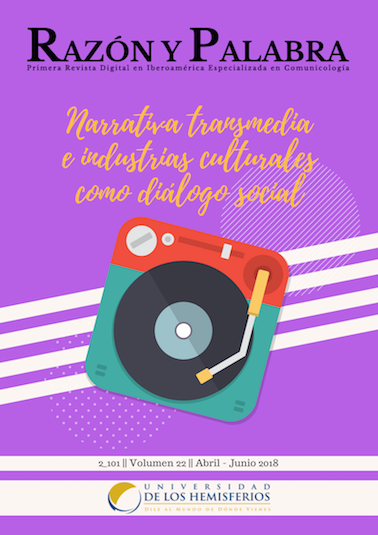Digital illiteracy: a barrier to transmedia storytelling and social dialogue on the sidelines of the culture
Main Article Content
Abstract
There are unfathomable barriers to access technologies for multi-platform interaction projects that allow social dialogue and its praxis –in the freireanii sense of reflection and action– on the sidelines of the culture industry. Transmedia storytelling urges for connection and digital convergence. On the one hand, it takes for granted stable internet connections and, on the other, full participation, dismissing digital illiteracy. This article focuses on the barriers that hampered implementing a transmedia service-learning project involving undergraduates and rural communities, mostly indigenous Kichwa of Chugchilán, located in the Andean moor of the province of Cotopaxi, in the central highlands of Ecuador. It also stresses on how to overcome these barriers to carry out future transmedia projects in rural communities.
Downloads
Article Details
References
Barranquero, A., y Rosique, G. (2014). La formación en comunicación/educación para el cambio social en la universidad española: Rutas para un diálogo interdisciplinar. Cuadernos.info, 83-102.
Bawden, D. (2008). Origins and Concepts of Digital Literacy. En C. Lankshear y M. Knobel (Eds.), Digital Literacies: Concepts, Policies, and Practices (pp. 17-32). New York: Peter Lang.
Castells, M. (2009). Comunicación y Poder. España: Alianza.
Espinosa, G. e. a. (2015). Actualización del Plan de Desarrollo y Ordenamiento Territorial del Cantón Sigchos. Sigchos: GAD Municipal de Sigchos, Cotopaxi. Recuperado de http://app.sni.gob.ec/sni-link/sni/PORTAL_SNI/data_sigad_plus/sigadplusdiagnostico/0560001190001_consolidado%20Diagn%C3%B3stico%20Sigchos_15-03-2015_20-43-37.pdf.
Freire, P. (2005). Pedagogia del oprimido (55.ed.). Madrid: Siglo veintiuno.
García Canclini, N. (1990). Culturas Híbridas. Estrategias para Entrar y Salir de la Modernidad. México: Grijalbo.
Gutiérrez Martín, A. (2003). Alfabetización digital. Algo más que botones y teclas Barcelona: Gedisa.
Haight, M., Quan-Haase, A., y Corbett, B. A. (2014). Revisiting the digital divide in Canada: the impact of demographic factors on access to the internet, level of online activity, and social networking site usage. Information, Communication & Society, 17(4), 503-519. doi:10.1080/1369118X.2014.891633
Herrera, O., Narváez, J. P., y Yánez, K. (2015). Plan de Desarrollo y Ordenamiento Territorial de la Parroquia Chugchilán 2015-2019. Chugchilán. Recuperado de http://app.sni.gob.ec/sni-link/sni/PORTAL_SNI/data_sigad_plus/sigadplusdocumentofinal/0560018910001_PDOT%20CHUGCHIL%C3%81N%202015_30-10-2015_23-27-05.pdf.
Horkheimer, M., y Adorno, T. W. (1998). La industrial cultural. Ilustración como engaño de masas Dialéctica de la ilustración. Fragmentos filosóficos. (pp. 165-212). Madrid: Editorial Trotta.
INEC. (2016). Tecnologías de la Información y Comunicaciones (TIC´S). Encuesta Nacional de Empleo Desempleo y Subempleo – ENEMDU (2012 – 2016). Recuperado de http://www.ecuadorencifras.gob.ec/documentos/web-inec/Estadisticas_Sociales/TIC/2016/170125.Presentacion_Tics_2016.pdf
INEC. (2017). El analfabetismo digital en Ecuador se reduce en 10 puntos desde el 2012. Recuperado de http://www.ecuadorencifras.gob.ec/el-analfabetismo-digital-en-ecuador-se-reduce-en-10-puntos-desde-el-2012/
Jacoby, B. (2015). Service-Learning Essentials. Questions, Answers, and Lessons Learned. USA: Jossey-Bass.
Jenkins, H. (2008). Convergence Culture. La cultura de la convergencia de los medias de comunicación. Barcelona: Paidós.
Lankshear, C., y Knobel, M. (2008). Digital Literacies: Concepts, Policies, and Practices. New York: Peter Lang.
Martin-Barbero, J. (2014). Pensar la Comunicación en
Latinoamérica.
Martin, A. (2008). Digital Literacy and the “Digital Society”. En C. Lankshear y M. Knobel (Eds.), Digital Literacies: Concepts, Policies, and Practices (pp. 151-176). New York: Peter Lang.
Meyers, E. M., Erickson, I., y Small, R. V. (2013). Digital literacy and informal learning environments: an introduction. Learning, Media and Technology, 38(4), 355-367. doi:10.1080/17439884.2013.783597
Obregon, R. (2014). Emerging Issues in Strategic Communication for Development and Social Change. En K. G. Wilkins, T. Tufte, y R. Obregon (Eds.), The handbook of development communication and social change (pp. 321-327). Chichester: John Wiley & Sons.
Regis-Martins-de-Oliveira, F., y Timponi-Pereira, R. (2017). “Legere et interpretari”: alfabetización mediática como metodología de aprendizaje. Razón y Palabra, 3(94), 868-884.
Rodríguez, C. (2010). Knowledges in dialogue: a participatory evaluation study of citizen's radio stations in Magdalena Medio, Colombia. En C. Rodríguez, D. Kidd, y L. Stein (Eds.), Making our media : global initiatives toward a democratic public sphere. (Vol. 1. Creating new communication spaces, pp. x, 338 s.). Cresskill, NJ: Hampton Press.
Rosas, M. C. (2012). El analfabetismo digital. ALAI. América Latina en Movimiento. Recuperado de https://www.alainet.org/es/active/57191
SIISE. (s/f). Analfabetismo Funcional. Indicadores del SIISE. Recuperado de http://www.siise.gob.ec/siiseweb/PageWebs/Educacion/ficedu_E02.htm
Tufte, T. (2015). Comunicación para el cambio social. Spain: Icaria editorial.
UNESCO. (s/f). Objetivos de Desarrollo Sostenible para la Comunicación y la Información. Recuperado de https://es.unesco.org/sdgs/ci
Wolton, D., y Morin, E. (2004). La comunicación, ayer y hoy: Entrevista de Dominique WOLTON a Edgar MORIN. Cuadernos de Información y Comunicación, (9), 203-212







